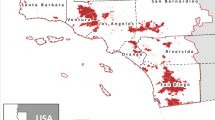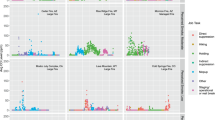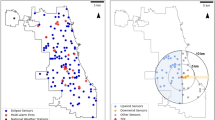Abstract
In this study, smoke data were collected from two plots located on the Francis Marion National Forest in South Carolina during prescribed burns on 12 February 2003. One of the plots had been subjected to mechanical chipping, the other was not. This study is part of a larger investigation of fire behavior related to mechanical chipping, parts of which are presented elsewhere. The primary objective of the study reported herein was to measure PM2.5 and CO exposures from prescribed burn smoke from a mechanically chipped vs. non-chipped site. Ground-level time-integrated PM2.5 samplers (n=9/plot) were placed at a height of 1.5 m around the sampling plots on the downwind side separated by approximately 20 m. Elevated time-integrated PM2.5 samplers (n=4/plot) were hung atop ∼30 ft poles at positions within the interior of each of the plots. Real-time PM2.5 and CO data were collected at downwind locations on the perimeter of each plot. Time-integrated perimeter 12-h PM2.5 concentrations in the non-chipped plot (AVG 519.9 μg/m3, SD 238.8 μg/m3) were significantly higher (1-tail P-value 0.01) than those at the chipped plot (AVG 198.1 μg/m3, SD 71.6 μg/m3). Similarly, interior time-integrated 8-h PM2.5 concentrations in the non-chipped plot (AVG 773.4 μg/m3, SD 321.8 μg/m3) were moderately higher (1-tail P-value 0.06) than those at the chipped plot (AVG 460.3 μg/m3, SD 147.3 μg/m3). Real-time PM2.5 and CO data measured at a position in the chipped plot were uniformly lower than those observed at the same position in the non-chipped plot over the same time period. These results demonstrate that smoke exposures resulting from burned chipped plots are considerably lower than from burned non-chipped plots. These findings have potentially important implications for both firefighters working prescribed burnings at chipped vs. non-chipped sites, as well as nearby communities who may be impacted from smoke traveling downwind from these sights.
This is a preview of subscription content, access via your institution
Access options
Subscribe to this journal
Receive 6 print issues and online access
$259.00 per year
only $43.17 per issue
Buy this article
- Purchase on Springer Link
- Instant access to full article PDF
Prices may be subject to local taxes which are calculated during checkout






Similar content being viewed by others
Notes
1000-h fuels: 1000 refers to the number of hours of drying post saturating rain necessary before that particular fuel diameter class reaches 63% of equilibrium moisture value. In practical terms this is the timelag before the fuel dries sufficiently to burn. It is the largest diameter class of downed fuels typically recognized in fuel sampling.
References
Achtemeier G.L. Planned Burn — Piedmont. A local operational numerical meteorological model for tracking smoke on the ground at night: Model development and sensitivity tests. Int J Wildland Fire 2005: 14: 85–98.
Achtemeier G.L., Glitzenstein J.S., and Naeher L.P. Measurements of smoke from chipped and unchipped plots. Southern J Appl Forestry 2006. (accepted for publication).
Achtemeier G.L., and Naeher L.P. Paper presented at Sixth Fire and Forest Meteorology, 2005. Symposium/19th Interior West Fire Council Meeting, Canmore, AB, Canada. Poster Presentation: Measurements of ground-level PM2.5 concentrations downwind from Southern prescribed burns. Oct 25–27, 2005.
American Conference of Governmental Industrial Hygienists. Online Threshold Limit Values. Last Updated 10/1/03. 2003: http://www.acgih.org/Products/tlvintro.htm.
Betchley C., Koenig J.Q., Van Belle G., Checkoway H., and Reinhardt T. Pulmonary function and respiratory symptoms in forest firefighters. Am J Ind Med 1997: 31: 503–509.
Carlton C.S. Personal PM2.5 Exposures for Firefighters Doing Prescribed Forest Burns in the Southeastern United States, 2004. A Master Thesis Submitted to the Graduate Faculty of the University of Georgia in Partial Fulfillment of the Requirements for the Degree. Athens, Georgia, 2004.
Carlton C., Naeher L.P., Macintosh D., Crowe M., Shea D., and Achtemeier G.L. International Society of Exposure Analysis 2003 International Conference, Stresa, Italy 2003. Poster/Oral Presentation: Personal PM2.5 exposures for fire fighters doing prescribed forest burns in the southeastern United States. September 2003.
Copper C.W., Mira M., Danforth M., Abraham K., Fasher B., and Bolton P. Acute exacerbations of asthma and bushfires. Lancet 1994: 343 (June 11): 1509.
Duclos P., Sanderson L.M., and Lipsett M. The 1987 forest fire disaster in California: assessment of emergency room visits. Arch Environ Health 1990: 45 (1): 53–58.
Federal Register. 29CFR1910.1000 Tables Z-1 through Z-3. Vol. 62. 42018, August 4, 1997, 1997: http://www.osha-slc.gov/SLTC/respiratory_advisor_genius_nrdl/z_tables.html.
Glitzenstein J. Personal Communication, 2005.
Glitzenstein J.S., Platt W.J., and Streng D.R. Effects of fire regime and habitat on tree dynamics in North Florida longleaf pine savannas. Ecol Monographs 1995: 65 (4): 441–476.
Glitzenstein J.S., Streng D.R., and Wade D.D. Fire frequency effects on longleaf pine (Pinus palustris P. Miller) vegetation in South Carolina and northeast FL. Natural Areas J 2003: 23: 22–37.
Glitzenstein J.S., Streng D.R., Achtemeier G.L., Naeher L.P., and Wade D.D. Fuels and Fire Behavior in Chipped and Unchipped Plots: Implications for Land Management near the Wildland/Urban Interface. Forest Ecol Manage 2006. (revision invited and in preparation).
Jalaludin B., Smith M., O'Toole B., and Leeder S. Acute effects of bushfires on peak expiratory flow rates in children with wheeze: a time series analysis. Aust N Z J Public Health 2000: 24 (2): 174–177.
Lavdas L.G. Program VSMOKE–users manual, 1996. USDA Forest Service General Technical Report SRS-6. 147pp.
Lee S., Baumann K., Schauer J.J., Sheesley R., Naeher L.P., Meinardi S., Blake D.R., Edgerton E.S., Russell A., and Clements M. Gaseous and particulate emissions from prescribed burning in Georgia. Env Sci Technol 2005: 39 (23): 9049–9056.
Letts D., Fidler A.T., Deitchman S., and Reh C.M. Health hazard evaluation prepared for the US Department of the Interior, National Park Service, Southern California, 1991. Report, in HETA 91-152-2140. 1991.
Liu D., Tager I.B., Balmes J.R., and Harrison R.J. The effect of smoke inhalation on lung function and airway responsiveness in wildland fire fighters, 1992. Am Rev Respir Dis 146: 1469–1473.
Materna B.L., Jones J.R., Sutton P.M., Rothman N., and Harrison R.J. Occupational exposures in California wildland fire fighting, 1992. Am Ind Hygiene Assoc J 53 (1): 69–76.
Morris R.D., and Naumova E.N. Carbon monoxide and hospital admissions for congestive heart failure: evidence of an increased effect at low temperatures, 1998. Environ Health Perspect 106: 649–653.
Mott J.A., Meyer P., Mannino D., Redd S.C., Smith E.M., Gotway-Crawford C., and Chase E. Wildland forest fire smoke: health effects and intervention evaluation, Hoopa, California, 1999, 2002. West J Med 176: 157–162.
Ottmar R.D., Peterson J.L., Leenhouts B., and Core J.E. Smoke management: techniques to reduce or redistribute emissions. In: Colin C. Hardy, Roger D. Ottmar, Janice L Peterson, John E. Core, Paula Seamon (Eds.). Smoke management guide for prescribed and wildland fire: 2001 edition PMS 420-2. NFES 1279. National Wildfire Coodination Group: Boise, ID, 2001, 226p. Ch. 8, pp. 141–159.
Reinhardt T.E. Monitoring Firefighter Exposure to Air Toxins at Prescribed Burns of Forest and Range Biomass. United States Dept. of Agriculture Research Paper 1991.
Reinhardt T.E., and Ottmar R.D. Smoke exposure at western wildfires, in US Department of Agriculture, Forest Service, Pacific Northwest Research Station, Research Paper, 2000. PNW-RP-525, 2000.
Reinhardt T.E., Ottmar R.D., and Hanneman A.J.S. Smoke Exposure Among Firefighters at Prescribed Burns in the Pacific Northwest, 2000, in United States Dept. of Agriculture Research Paper. 2000.
Rothman N., Ford P., Baser M.E., Hansen J.A., O'Toole T., Tockman M.S., and Strickland P.T. Pulmonary function and respiratory symptoms in wildland firefighters. J Occup Med 1991: 33 (11): 1163–1167.
Serra A., Mocci F., and Randaccio F.S. Pulmonary function in Sardinian firefighters. Am J Ind Med 1996: 30: 70–78.
Slaughter J.C., Koenig J.Q., and Reinhardt T.E. Association between lung function and exposure to smoke among firefighters at prescribed burns. J Occup Environ Hyg 2004: 1 (1): 45–49.
Smith M., Jalaludin B., Byles J.E., Lim L., and Leeder S.R. Asthma presentations to emergency departments in western Sydney during the January 1994 Bushfires. Int J Epidemiol 1996: 25 (6): 1227–1236.
Sorenson B., Fuss M., Mulla Z., Bigler W., Wiersma S., and Hopkins R. Surveillance of Morbidity During Wildfires — Central Florida, 1998. MMWR 1999: 48 (4): 78–79.
Streng D.R., Glitzenstein J.S., Achtemeier G.L., Naeher L.P., and Wade D.D. Fire in chipped and non-chipped plots: ecological implications for vegetative material (in preparation), 2006.
Sutherland E.R., Make B.J., Vedal S., Zhang L., Dutton S.J., Muphy J.R., and Silkoff P.E. Wildfire smoke and respiratory symptoms in patients with chronic obstructive pulmonary disease. JAllergy Clin Immunol 2005: 115 (2): 420–422.
US Environmental Protection Agency. 1996: http://www.epa.gov/air/airtrends/aqtrnd97/brochure/pm10.html.
U.S. Environmental Protection Agency. Chemical/Name Index to EPA Test Methods (April 2003), PM2.5, CFR 50 Appl L, 2003.
Wade D.D., Brock B.L., Brose P.H., Grace J.B., Hoch G.A., and Patterson III W.A. Chapter 4:53–96 Fire in eastern ecosystems. In: Brown J.K. and Smith J.K. (Eds.). Wildland Fire in Ecosystems: Effects of Fire on Flora Gen. Tech. Rep. RMRS-GTR-42- Vol. 2. Ogden, UT: U.S. Department of Agriculture, Forest Service, Rocky Mountain Research Station, 2000.
Yang W., Jennison B.L., and Omaye S.T. Cardiovascular disease hospitalization and ambient levels of carbon monoxide. J Toxicol Environ Health 1998: 55 (Part A): 185–196.
Yanosky J.D. Fine Particle Exposure of Prescribed Fire Workers in the Southeastern United States and a Comparison of Several Particulate Matter Sampling Methods, 2001. A Master Thesis Submitted to the Graduate Faculty of the University of Georgia in Partial Fulfillment of the Requirements for the Degree. Athens, Georgia, 2001.
Acknowledgements
We thank University of Georgia technicians Jeffrey Yanosky, Robert Robinson, Cameron Carlton, Krista Merry and Dean Hardy for their help with data collection and analysis. Thanks also go to FMNF Fire Management Officer Eddie Stroman, and the FMNF Burn Crew. Last, thanks also go to John Brubaker, who suggested the pole technique for mounting the PM2.5 sensors.
Author information
Authors and Affiliations
Corresponding author
Additional information
Funding: United States Department of Agriculture, Forest Service
Rights and permissions
About this article
Cite this article
Naeher, L., Achtemeier, G., Glitzenstein, J. et al. Real-time and time-integrated PM2.5 and CO from prescribed burns in chipped and non-chipped plots: firefighter and community exposure and health implications. J Expo Sci Environ Epidemiol 16, 351–361 (2006). https://doi.org/10.1038/sj.jes.7500497
Received:
Revised:
Accepted:
Published:
Issue Date:
DOI: https://doi.org/10.1038/sj.jes.7500497
Keywords
This article is cited by
-
Respiratory Exposure Study for Fire Fighters and Other Emergency Responders
Fire Technology (2010)
-
Biological monitoring of smoke exposure among wildland firefighters: A pilot study comparing urinary methoxyphenols with personal exposures to carbon monoxide, particular matter, and levoglucosan
Journal of Exposure Science & Environmental Epidemiology (2009)



